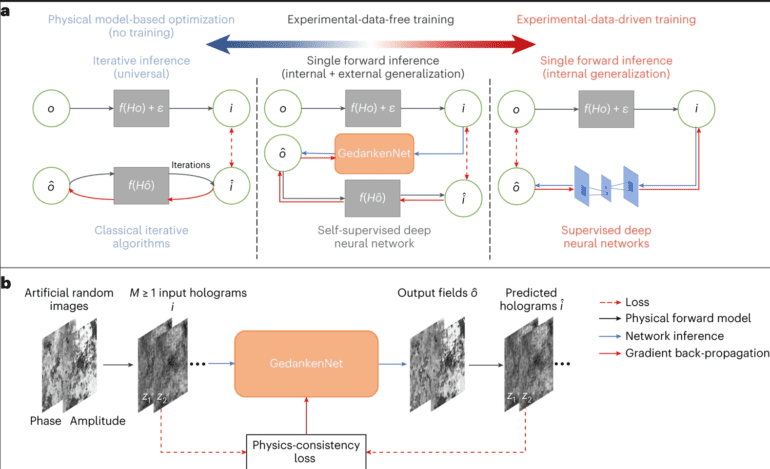TL;DR:
- Recent advances in deep learning have transformed computational imaging, microscopy, and holography.
- UCLA’s GedankenNet introduces a self-supervised approach to learning, sidestepping the need for labeled data.
- This novel framework relies on physics consistency and artificial imagery to overcome traditional limitations.
- GedankenNet’s architecture, using Spatial Fourier Transformation blocks, maintains accuracy and generalizes well.
- Performance evaluations show GedankenNet excels in hologram reconstruction, outperforming traditional methods.
- The model’s physics-consistency loss minimizes artifacts, leading to sharper reconstructions.
- GedankenNet’s superiority in external generalization positions it to handle novel experimental data effectively.
Main AI News:
The landscape of computational imaging, microscopy, and holography is undergoing a seismic transformation, powered by recent strides in deep learning. These technological breakthroughs find their application in an array of domains, from biomedical imaging and diagnostics to the realm of 3D displays and sensing. Through its prowess in tasks like image enhancement, translation, denoising, super-resolution, and virtual staining, deep learning has showcased unparalleled flexibility and efficacy. It’s within the intricate world of microscopic dimensions, encompassing techniques like bright-field and fluorescence microscopy, that the convergence of deep learning has ushered in a new era of perception and insight.
Traditionally, the arena of computational imaging has been dominated by supervised learning models, demanding substantial datasets adorned with annotations or ground-truth experimental images. This often involves gathering labeled training data through a medley of methodologies – be it classical algorithms or paired images from disparate imaging modalities. Yet, these techniques come with their constraints, including the labor-intensive process of data acquisition, alignment, preprocessing, and the lurking specter of inference bias. Even with the advent of unsupervised and self-supervised learning, the reliance on empirical measurements or sample labels remains unshaken. Attempts at employing labeled simulated data for training have been made, but the faithful representation of experimental sample distributions remains an intricate puzzle, demanding insights into sample attributes and imaging setups.
In a bid to unravel these inherent challenges, scholars from the distinguished UCLA Samueli School of Engineering have birthed an avant-garde solution christened GedankenNet. This innovative brainchild charts uncharted territory with its revolutionary self-supervised learning framework. In a stark departure from the norm, GedankenNet dispenses with the need for labeled or experimental training data, venturing far from the shadows of real-world samples. Its training protocol, anchored in the bedrock of physics consistency and artificial random imagery, surmounts the trials posed by existing paradigms. It emerges as a beacon of hope in the realm of hologram reconstruction, offering a panacea for the limitations that shackle conventional supervised learning methodologies, frequently employed across a gamut of microscopy, holography, and computational imaging assignments.
At its core, GedankenNet is a symphony of Spatial Fourier Transformation (SPAF) blocks, intricately linked by resilient connections, meticulously designed to encapsulate both spatial and frequency domain information. Infused with a physics-consistency loss function, this model is a guardian of the wave equation’s sanctity during hologram reconstruction, culminating in outputs that are nothing short of a faithful embodiment of the complex field. This unique training mechanism empowers GedankenNet to transcend its boundaries, adapting seamlessly to synthetic and experimental holograms, unflinchingly facing unfamiliar samples, axial defocus, and shifts in illumination wavelength.
Through an exhaustive performance evaluation, the prowess of GedankenNet in hologram reconstruction becomes indisputably apparent. Metrics such as Structural Similarity Index (SSIM), Root Mean Square Error (RMSE), and Error Correction Coefficient (ECC) converge to sing praises of GedankenNet’s consistency in outperforming traditional supervised techniques across a sweeping spectrum of holographic endeavors. Perhaps the most captivating facet lies in the efficacy of GedankenNet’s physics consistency loss, acting as a vigilant sentinel against non-physical artifacts, resulting in reconstructions that are sharper and more precise. The model’s unswerving alignment with the wave equation bestows upon it a virtuoso status, enabling it to resurrect object fields of the utmost quality from defocused holograms through unerring wave propagation. These revelations accentuate GedankenNet’s ascendancy in transcending limits, enabling it to master novel experimental data and phase-only samples with an exquisite fidelity that’s second to none.
Conclusion:
GedankenNet’s emergence as a revolutionary self-supervised approach marks a significant turning point for the market of computational imaging. By discarding the need for labor-intensive labeled training data, this innovative methodology not only enhances accuracy but also opens avenues for rapid adaptation to new experimental data. Its prowess in hologram reconstruction and artifact minimization positions GedankenNet as a market leader, offering businesses enhanced capabilities in microscopy, holography, and computational imaging. As industries seek ever more sophisticated solutions, GedankenNet’s capacity to handle novel data and improve image quality stands to reshape the landscape of visual technologies.

